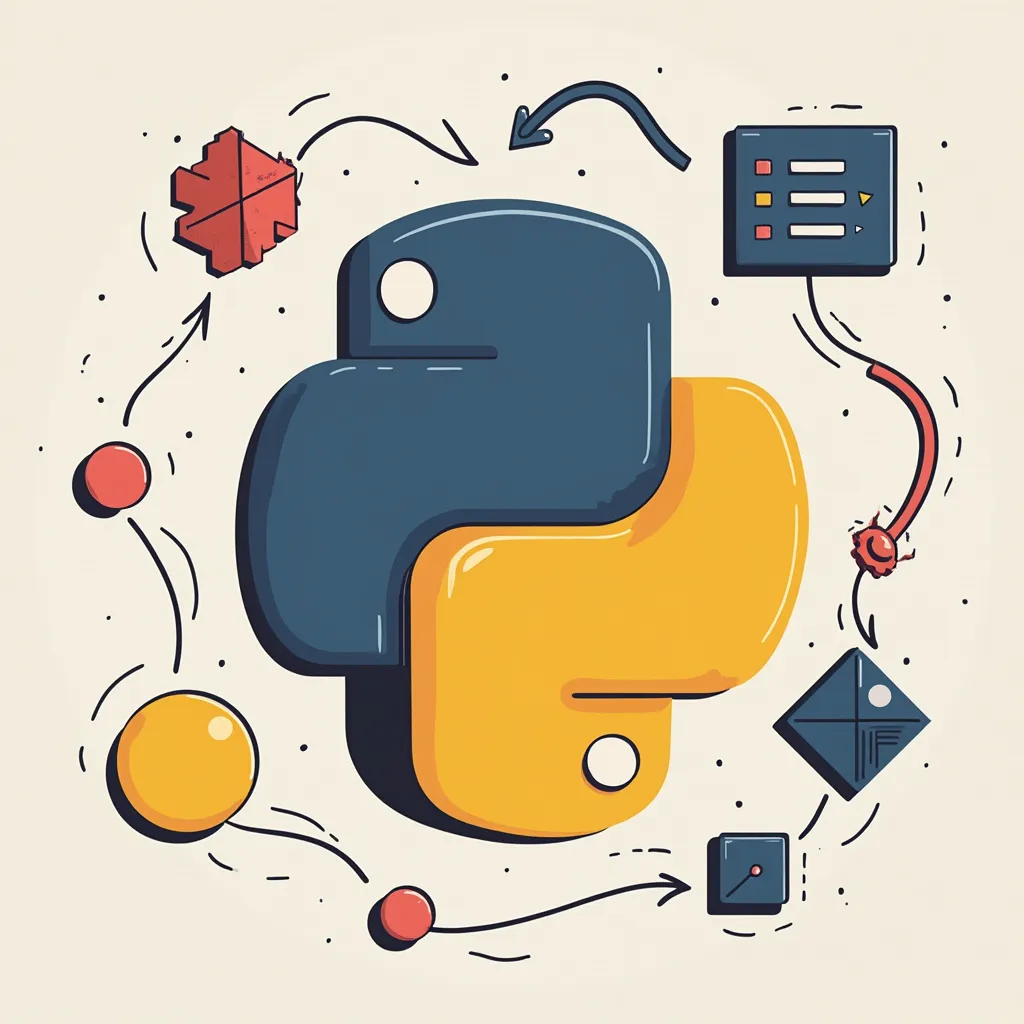As a Python developer, you're probably familiar with the usual suspects: print(), len(), range(), and their popular friends. But Python, like an eccentric uncle with a penchant for magic tricks, has a few more aces up its sleeve. Today, we're going to explore some of the lesser-known built-in functions that can significantly improve your code efficiency and readability. These hidden gems are like finding an extra fry at the bottom of your fast-food bag � unexpected, delightful, and oddly satisfying.
1. enumerate(): Your Index's New Best Friend
Let's kick things off with enumerate(). This function is the superhero of iterating with index tracking. Instead of manually keeping track of indices like it's 1999, enumerate() does the heavy lifting for you.
Consider this common scenario:
fruits = ['apple', 'banana', 'cherry']
for i in range(len(fruits)):
print(f"Index {i}: {fruits[i]}")Now, behold the elegance of enumerate():
fruits = ['apple', 'banana', 'cherry']
for index, fruit in enumerate(fruits):
print(f"Index {index}: {fruit}")Not only is this more readable, but it's also more efficient. enumerate() returns an iterator of tuples containing the index and value, saving you from unnecessary indexing operations.
But wait, there's more! enumerate() can start from any number you want:
for index, fruit in enumerate(fruits, start=1):
print(f"Fruit #{index}: {fruit}")This is particularly useful when you're dealing with 1-indexed data or want to start your count from a specific number.
2. zip(): The List Whisperer
Next up is zip(), the function that brings lists together like a matchmaker on a mission. It pairs up elements from multiple iterables, creating an iterator of tuples.
names = ['Alice', 'Bob', 'Charlie']
ages = [25, 30, 35]
for name, age in zip(names, ages):
print(f"{name} is {age} years old")zip() is incredibly versatile. Need to create a dictionary from two lists? zip() has got your back:
dict(zip(names, ages)) # {'Alice': 25, 'Bob': 30, 'Charlie': 35}But be careful! zip() stops at the shortest iterable. If you need to handle iterables of unequal length, check out itertools.zip_longest().
3. any() and all(): The Boolean Buddies
These functions are like the dynamic duo of boolean operations. any() returns True if any element in an iterable is True, while all() returns True only if all elements are True.
numbers = [1, 2, 3, 4, 5]
print(any(num > 3 for num in numbers)) # True
print(all(num > 3 for num in numbers)) # FalseThese functions shine when you need to check conditions across an entire iterable. They're particularly useful with generator expressions, allowing for efficient evaluation of large datasets.
4. functools.partial(): The Function Customizer
Tucked away in the functools module, partial() is like a tailor for your functions. It allows you to create new versions of functions with some arguments pre-set.
from functools import partial
def power(base, exponent):
return base ** exponent
square = partial(power, exponent=2)
cube = partial(power, exponent=3)
print(square(4)) # 16
print(cube(4)) # 64This is incredibly useful when you're working with functions that take multiple arguments, but you frequently use them with some arguments fixed.
5. iter(): The Iteration Innovator
iter() is the unsung hero of efficient iteration. It can turn objects into iterators, but its real power shines when used with a sentinel value.
def read_until_empty():
return iter(input, '')
for line in read_until_empty():
print(f"You entered: {line}")This will keep asking for input until an empty string is entered. It's a clean way to handle input without cluttering your code with while loops and break statements.
6. filter(): The Data Sifter
filter() is like a bouncer for your data, only letting in the elements that meet certain criteria. It takes a function and an iterable, returning an iterator yielding those elements for which the function returns True.
numbers = range(-5, 6)
positive = list(filter(lambda x: x > 0, numbers))
print(positive) # [1, 2, 3, 4, 5]While list comprehensions can often replace filter(), it still has its place, especially when working with existing functions or complex filtering logic.
7. map(): The Data Transformer
map() applies a function to every item in an iterable, returning an iterator of the results. It's like having a personal assistant that modifies each element in your data according to your specifications.
numbers = [1, 2, 3, 4, 5]
squared = list(map(lambda x: x**2, numbers))
print(squared) # [1, 4, 9, 16, 25]Like filter(), map() can often be replaced by list comprehensions, but it remains useful, especially when working with multiple iterables:
list(map(pow, [2, 3, 4], [3, 2, 1])) # [8, 9, 4]8. functools.reduce(): The List Collapser
reduce() is the Swiss Army knife of list processing. It applies a function of two arguments cumulatively to the items of a sequence, reducing it to a single value.
from functools import reduce
numbers = [1, 2, 3, 4, 5]
product = reduce(lambda x, y: x * y, numbers)
print(product) # 120While powerful, reduce() can sometimes lead to less readable code. Use it judiciously, and consider alternatives like sum(), max(), or min() for common reduction operations.
9. itertools.chain(): The Iteration Chainsaw
chain() from the itertools module is like a master link, connecting multiple iterables into a single, seamless iterator.
from itertools import chain
numbers = [1, 2, 3]
letters = ['a', 'b', 'c']
combined = list(chain(numbers, letters))
print(combined) # [1, 2, 3, 'a', 'b', 'c']This is particularly useful when you need to process multiple iterables as if they were a single sequence, without creating intermediate lists.
10. collections.defaultdict(): The Default Value Defender
defaultdict is a subclass of dict that calls a factory function to supply missing values. It's like having a safety net for your dictionaries, ensuring you never get a KeyError.
from collections import defaultdict
word_count = defaultdict(int)
for word in "the quick brown fox jumps over the lazy dog".split():
word_count[word] += 1
print(word_count)
# defaultdict(<class 'int'>, {'the': 2, 'quick': 1, 'brown': 1, 'fox': 1, 'jumps': 1, 'over': 1, 'lazy': 1, 'dog': 1})This eliminates the need for verbose key existence checks and initializations, making your code cleaner and more efficient.
11. itertools.groupby(): The Data Groupie
groupby() is like a backstage pass for your data, grouping consecutive elements based on a key function.
from itertools import groupby
data = [1, 1, 1, 2, 2, 3, 4, 4, 5, 1]
for key, group in groupby(data):
print(f"{key}: {list(group)}")
# Output:
# 1: [1, 1, 1]
# 2: [2, 2]
# 3: [3]
# 4: [4, 4]
# 5: [5]
# 1: [1]Remember, groupby() only groups consecutive elements. If you need to group all occurrences, sort your data first.
12. functools.lru_cache(): The Memoization Maestro
lru_cache is a decorator that implements memoization, caching the results of a function based on its arguments. It's like giving your function a photographic memory for its previous calls.
from functools import lru_cache
@lru_cache(maxsize=None)
def fibonacci(n):
if n < 2:
return n
return fibonacci(n-1) + fibonacci(n-2)
print(fibonacci(100)) # Blazing fast!This can dramatically speed up recursive functions or any function with expensive computations and repeated calls with the same arguments.
Conclusion: Unleashing Python's Hidden Power
By incorporating these functions into your Python toolkit, you can write code that's not only more efficient but also more expressive and Pythonic. They allow you to communicate your intent more clearly, often reducing complex operations to a single, readable line.
Happy coding, and may your Python scripts be forever efficient, readable, and just a little bit magical. And remember, in the wise words of Tim Peters in "The Zen of Python": "There should be one-- and preferably only one --obvious way to do it."
If you're interested in diving deeper into Python's capabilities, check out our articles on mastering Python for loops and understanding slice notation. For those looking to optimize their code further, our guide on fixing a broken Python environment might come in handy.
For startup founders and tech entrepreneurs, these Python techniques can be invaluable. Learn more about applying these skills in a startup context in our article on decoding tech entrepreneurship.
-Sethers



